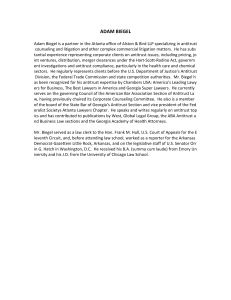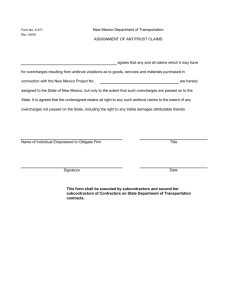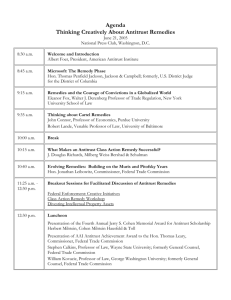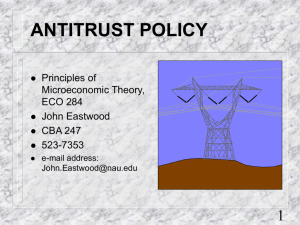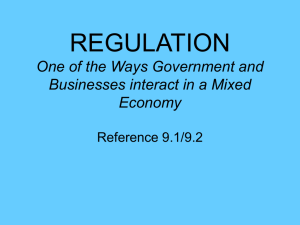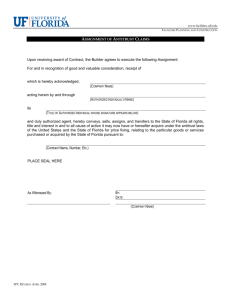program title - American Bar Association
advertisement
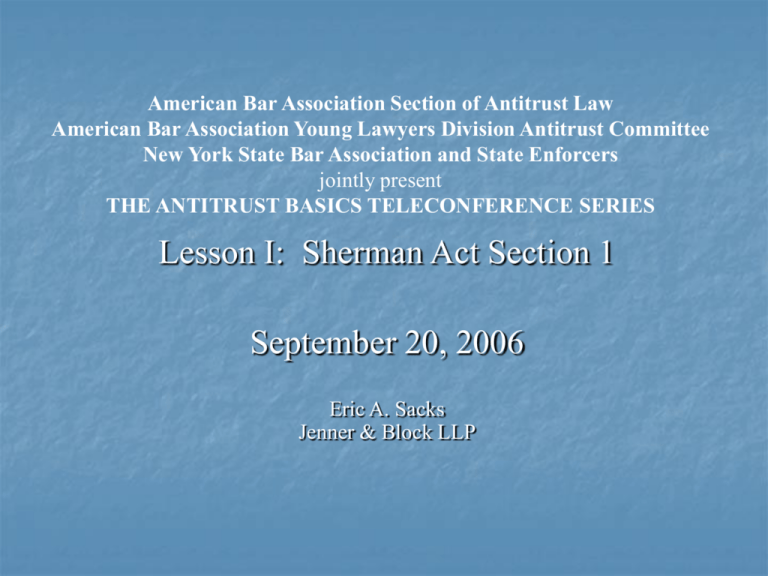
American Bar Association Section of Antitrust Law American Bar Association Young Lawyers Division Antitrust Committee New York State Bar Association and State Enforcers jointly present THE ANTITRUST BASICS TELECONFERENCE SERIES Lesson I: Sherman Act Section 1 September 20, 2006 Eric A. Sacks Jenner & Block LLP “Every contract, combination . . . , or conspiracy, in restraint of trade . . . is declared to be illegal.” 15 U.S.C. § 1. 2 Only unreasonable restraints are illegal. Compare Standard Oil Co. of New Jersey v. United States, 221 U.S. 1 (1911), with United States v. Trans-Missouri Freight Ass’n, 166 U.S. 290 (1897); see also Board of Trade of City of Chicago v. United States, 246 U.S. 231, 238 (1918), see also Phillip Areeda & Louis Kaplow, Antitrust Analysis ¶¶ 204-207 (4th ed. 1988). 3 Elements of Section 1 Claim Civil antitrust claims: − Standing − Antitrust Injury − Causation − Damages • • Section 1: − Agreement that is − Unreasonable 4 The Agreement Element • Express – Direct Evidence – Circumstantial Evidence • Tacit – Parallel conduct – Independent action? See Phillip Areeda & Louis Kaplow, Antitrust Analysis ¶ 236 (4th ed. 1988). 5 Direct Evidence • • • • Contracts Corporate and Transactional Documents Rules Testimony 6 Circumstantial Evidence • “Conscious commitment to a common scheme designed to achieve an unlawful objective.” Monsanto Co. v. Spray-Rite Serv. Corp., 465 U.S. 752, 768 (1984). • Evidence that “tends to exclude the possibility” of independent conduct. Id.; see also Matsushita Elec. Indus. Co., Ltd. v. Zenith Radio Corp., 475 U.S. 574, 588 (1986). 7 Circumstantial Evidence Parallel Conduct (“conscious parallelism”) and “plus factors” See VI Phillip E. Areeda & Herbert Hovenkamp, Antitrust Law ¶¶ 1433, 1434 (2d ed. 2003); In re Baby Food Antitrust Litig., 166 F.3d 112, 122 (3d Cir. 1999); Petruzzi’s IGA Supermarkets, Inc. v. Darling-Delaware Co., Inc. 998 F.2d 1224, 1243 (3d Cir. 1993). 8 “Plus” Factors • • • Suggestion of traditional conspiracy (“facilitating practices”) Action against economic-interests? Motivation to conspire? See VI Phillip E. Areeda & Herbert Hovenkamp, Antitrust Law ¶ 1434 (2d ed. 2003); In re Baby Food Antitrust Litig., 166 F.3d 112, 127 (3rd Cir. 1999); Petruzzi’s IGA Supermarkets, Inc. v. Darling-Delaware Co., Inc. 998 F.2d 1224, 124244 (3rd Cir. 1993). 9 Parties to the Agreement • Competitors • “Partners” – Horizontal Agreement (Interbrand Competition) – Vertical Agreement (Intrabrand Competition) Compare Palmer v. BRG of Georgia, Inc, 498 U.S. 46 (1990), with Continental T.V., Inc. v . GTE Sylvania, Inc., 433 U.S. 36 (1977); see also United States v. Topco Associates, Inc., 405 U.S. 596 (1972). • Corporate Affiliates – No Agreement? Copperweld Corp. v. Independence Tube Corp., 467 U.S. 752 (1984). 10 Unreasonable Restraint Element • Rule of Reason • Per Se Rule • Alternatives: “Quick Look” Doctrines 11 Rule of Reason • Do one or more parties to the restraint have the ability to harm competition? − • Does the restraint help more than it hurts? − • Market Power Gate Balancing of benefits (pro-competitive virtues) with costs (anticompetitive vices) Can the benefits of the restraint be obtained without all of its costs? − “Least restrictive alternative” See VII Phillip E. Areeda & Herbert Hovenkamp, Antitrust Law ¶ 1502 at 345-46 (2d ed. 2003); see also Board of Trade of City of Chicago v. United States, 246 U.S. 231, 238 (1918). 12 Market Power Gate • Indirect Proof − • Market share in properly defined “relevant market” Direct Proof − Increase price or decrease output without significant profit loss 13 Example of Business Justifications • Restraint Increases Output • Restraint Lowers Price • Restraint Promotes Brand Investment − Prevents “free-riding” 14 Per Se Rule • Because of “pernicious effect on competition and lack of ANY redeeming virtue,” a restraint is “conclusively presumed to be unreasonable” Northern Pac. Ry. Co. v. United States, 356 U.S. 1, 5 (1958) (emphasis added). • • Categories Court experience 15 Per Se Illegal Restraints • Horizontal Price Fixing United States v. Socony-Vacuum Oil Co., 310 U.S. 150 (1940). • Vertical Price Fixing (Resale Price Maintenance) Dr. Miles Medical Co. v. John D. Park & Sons Co., 220 U.S. 373 (1911). • Horizontal Market Division Palmer v. BRG of Georgia, Inc., 498 U.S. 46 (1990). • Some Horizontal Boycotts Compare Northwest Wholesale Stationers, Inc. v. Pacific Stationery & Printing Co., 472 U.S. 284, 29598 (1985), with Klor’s, Inc. v. Broadway-Hale Stores, Inc., 359 U.S. 207, 212 (1959). • Some Tying Arrangements Jefferson Parish Hospital Dist. No. 2 v. Hyde, 466 U.S. 2, 15-16 16 (1984). Rigid Approach Old School • • No consideration of possible procompetitive virtues Even when they are plausible United States v. Topco Associates, Inc., 405 U.S. 596, 609-10 (1972). 17 Alternative Approaches New School • Ancillary restraints doctrine − − • Naked restraint? “Quick look” See VII Phillip E. Areeda & Herbert Hovenkamp, Antitrust Law ¶ 1511c at 420-421 (2d ed. 2003); Polk Brothers, Inc. v. Forest City Enters., Inc., 776 F.2d 185, 188-89 (7th Cir. 1985); see also Rothery Storage & Van Co. v. Altas Van Lines, Inc., 792 F.2d 210 (D.C. Cir. 1986); Joel I. Klein, Acting Assistant Attorney General, Antitrust Division, A Stepwise Approach to Antitrust Review of Horizontal Agreements, Remarks Before the American Bar Association’s Antitrust Section Semi-Annual Fall Policy Program (November 7, 1996) (available at 1996 WL 655653). Truncated rule of reason − − Condemnation without “elaborate industry analysis” “Quick look” See California Dental Ass’n v. FTC, 526 U.S. 756; 769-70 (1999); Law v. NCAA, 134 F.3d 1010, 1020 (10th Cir. 1998); see also NCAA v. Board of Regents of Univ. of Okla., 468 U.S. 85, 109-10, & n.39 (1984); FTC v. Indiana Federation of Dentists, 476 U.S. 447, 459 (1986). 18 Challenging Section 1 Organizations • • • Cooperative Ventures Associations Standard Setting Organizations 19 Cooperative Ventures • Legitimate vs. Sham − − − − • Pro-competitive Cooperation Creation or Promotion of a Product or Service Risk Sharing Integration Ancillary Restraint? Timken Roller Bearing Co. v. United States, 341 U.S. 593 (1951), overruled on other issue by Copperweld Corp. v. Independence Tube Corp., 467 U.S. 752 (1984); see also Engine Specialties, Inc. v. Bombardier Ltd., 605 F.2d 1, 8-11 (1st Cir. 1979). Compare Polk Brothers, Inc. v. Forest City Enters., Inc., 776 F.2d 185, 188-89 (7th Cir. 1985), with Polygram Holding, Inc. v. FTC, 416 F.3d 29, 36-38 (D.C. Cir. 2005). 20 Associations • Information Gathering and Sharing • Help for Cartel or Boycott? California Dental Ass’n v. FTC, 526 U.S. 756 (1999); Fashion Originators’ Guild of America v. FTC, 312 U.S. 457 (1941). 21 Standard Setting Organizations • Opportunity for Pro-Competitive Virtues • Opportunity for Exclusion − − Safeguards “Subversion” Allied Tube & Conduit Corp. v. Indian Head, Inc., 486 U.S. 492, 500-01, 506-09 (1988); American Society of Mechanical Engineers, Inc. v. Hydrolevel Corp., 456 U.S. 556 (1982); Radiant Burners, Inc. v. Peoples Gas Light & Coke Co., 364 U.S. 656 (1961). 22 Vertical Restraints • Non-price – Rule of Reason – Free Riding Continental T.V., Inc. v. GTE Sylvania Inc., 433 U.S. 36 (1977); see also Business Elecs. Corp. v. Sharp Elecs. Corp., 485 U.S. 717 (1988). • Maximum Price – Rule of Reason State Oil Co. v. Khan, 522 U.S. 3 (1997). • Minimum Price – Per Se Dr. Miles Medical Co. v. John D. Park & Sons Co., 220 U.S. 373 (1911). 23 Resources • Phillip Areeda & Louis Kaplow, Antitrust Analysis (4th ed. 1988). • VI & VII Phillip E. Areeda & Herbert Hovenkamp, Antitrust Law (2d ed. 2003). • See also ABA Section of Antitrust Law, Model Jury Instructions in Civil Antitrust Cases, 2005 Edition (2005). 24

